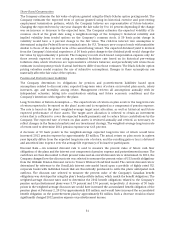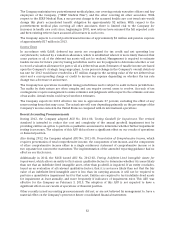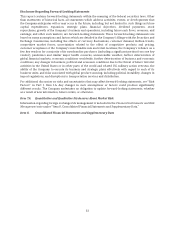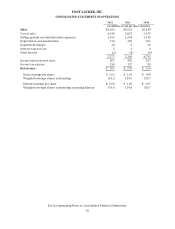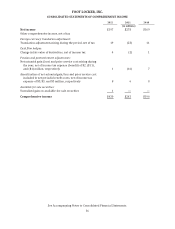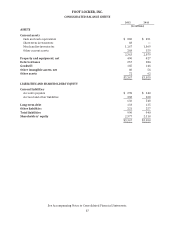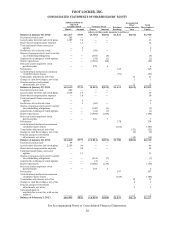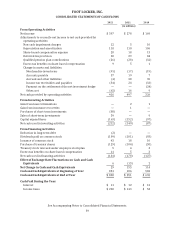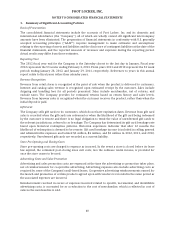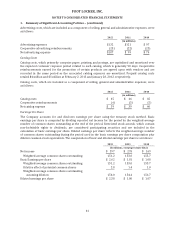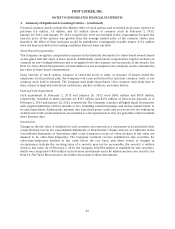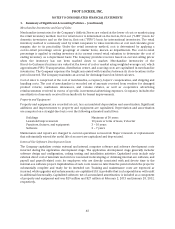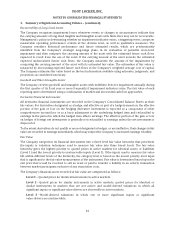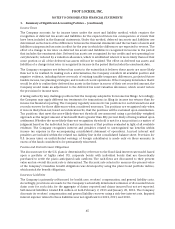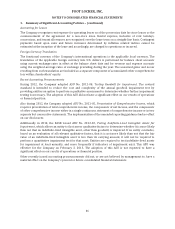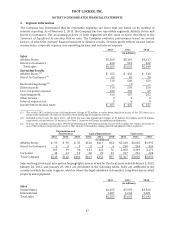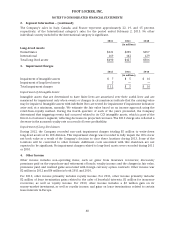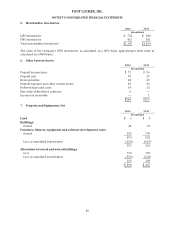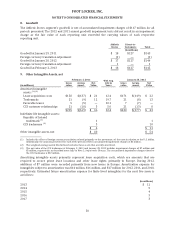Foot Locker 2012 Annual Report Download - page 60
Download and view the complete annual report
Please find page 60 of the 2012 Foot Locker annual report below. You can navigate through the pages in the report by either clicking on the pages listed below, or by using the keyword search tool below to find specific information within the annual report.FOOT LOCKER, INC.
NOTES TO CONSOLIDATED FINANCIAL STATEMENTS
1. Summary of Significant Accounting Policies
Basis of Presentation
The consolidated financial statements include the accounts of Foot Locker, Inc. and its domestic and
international subsidiaries (the ‘‘Company’’), all of which are wholly owned. All significant intercompany
amounts have been eliminated. The preparation of financial statements in conformity with U.S. generally
accepted accounting principles (‘‘GAAP’’) requires management to make estimates and assumptions
relating to the reporting of assets and liabilities and the disclosure of contingent liabilities at the date of the
financial statements, and the reported amounts of revenues and expenses during the reporting period.
Actual results may differ from those estimates.
Reporting Year
The 2012 fiscal year end for the Company is the Saturday closest to the last day in January. Fiscal year
2012 represents the 53 weeks ending February 2, 2013. Fiscal years 2011 and 2010 represent the 52 week
periods ending January 28, 2012, and January 29, 2011, respectively. References to years in this annual
report relate to fiscal years rather than calendar years.
Revenue Recognition
Revenue from retail stores is recognized at the point of sale when the product is delivered to customers.
Internet and catalog sales revenue is recognized upon estimated receipt by the customer. Sales include
shipping and handling fees for all periods presented. Sales include merchandise, net of returns, and
exclude taxes. The Company provides for estimated returns based on return history and sales levels.
Revenue from layaway sales is recognized when the customer receives the product, rather than when the
initial deposit is paid.
Gift Cards
The Company sells gift cards to its customers, which do not have expiration dates. Revenue from gift card
sales is recorded when the gift cards are redeemed or when the likelihood of the gift card being redeemed
by the customer is remote and there is no legal obligation to remit the value of unredeemed gift cards to
the relevant jurisdictions, referred to as breakage. The Company has determined its gift card breakage rate
based upon historical redemption patterns. Historical experience indicates that after 12 months the
likelihood of redemption is deemed to be remote. Gift card breakage income is included in selling, general
and administrative expenses and totaled $3 million, $4 million, and $2 million in 2012, 2011, and 2010,
respectively. Unredeemed gift cards are recorded as a current liability.
Store Pre-Opening and Closing Costs
Store pre-opening costs are charged to expense as incurred. In the event a store is closed before its lease
has expired, the estimated post-closing lease exit costs, less the sublease rental income, is provided for
once the store ceases to be used.
Advertising Costs and Sales Promotion
Advertising and sales promotion costs are expensed at the time the advertising or promotion takes place,
net of reimbursements for cooperative advertising. Advertising expenses also include advertising costs as
required by some of the Company’s mall-based leases. Cooperative advertising reimbursements earned for
the launch and promotion of certain products agreed upon with vendors is recorded in the same period as
the associated expenses are incurred.
Reimbursement received in excess of expenses incurred related to specific, incremental, and identifiable
advertising costs, is accounted for as a reduction to the cost of merchandise, which is reflected in cost of
sales as the merchandise is sold.
40



